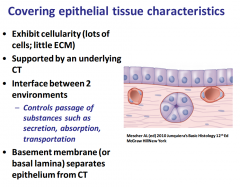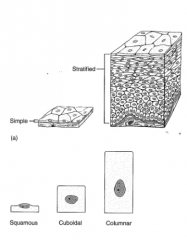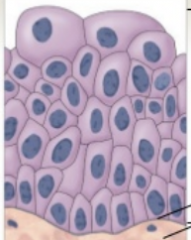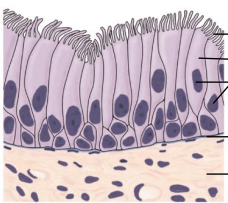![]()
![]()
![]()
Use LEFT and RIGHT arrow keys to navigate between flashcards;
Use UP and DOWN arrow keys to flip the card;
H to show hint;
A reads text to speech;
19 Cards in this Set
- Front
- Back
|
How many types of tissues are there? |
4 different types |
|
|
What are the different names for epithelium? |
Simple squamous Simple cuboidal Simple columnar Stratified squamous Stratified cuboidal Stratified columnar |
|
|
What are the two categories for epithelial tissue? |
- Covering and lining epithelium (skin) - Glandular epithelium |
|
|
Details of glandular epithelium |

(Remember: 2 different kinds of glands) |
|
|
Details of covering epithelium |

|
|
|
How are epithelial tissues categorised? |

- By the number of epithelial cell layers E.g. 1 cell layer = simple 2+ cell layers = stratified - By the shape of the apical layer (top layers, seen in image) |
|
|
What are the functions of simple and stratified structures? |
Simple = transfer between environments (absorption and secretion) Stratified = protective barrier (thicker) |
|
|
Details about simple squamous |
- Most delicate - Found in protected areas where absorption and diffusion occurs on a slippery surface to reduce friction - Lining internal body cavities = mesothelium - Endothelium = lines heart and blood vessels |
|
|
Details about stratified squamous |
- Located where mechanical (or chemical) stress occurs. E.g. gut |
|
|
Details about cuboidal epithelium |
- Looks hexagonal - Simple = lines exocrine glands and ducts as well as kidneys - Stratified = rare and appears in sweat and mammary glands |
|
|
What is transitional epithelium? |

It is unusual stratified epithelium (especially for repeated cycles of stretching, like the bladder) |
|
|
Details about simple columnar |
- Found in lining of stomach and intestines - May have surface microvilli or cilia |
|
|
Details about pseudostratified columnar epithelium |

- Includes several cell types with varying shapes and functions - Top of cells are not level |
|
|
Details about stratified columnar |
- Rarely found - Found in large ducts such as salivary gland |
|
|
What is connective tissue? |
- Most abundant - 3 main properties = Cells, fibres and matrix |
|
|
What cells are present in connective tissue? |
- Structural cells = synthesising and storing (fats adipose etc) - Immature cells known as "blasts" (Secrete ECM and will divide into mature cells) - Mature cells known as "cytes" - Defence cells (protect body from invasion) |
|
|
What is the matrix of connective tissue? |
- Found between cells and fibres E.g: – Fluid (Blood) – Semifluid (Cartilage) – Gelatinous (most others) – Hard (Bone) – Secures CT cells & fibres within the ECM - Provide a medium for substance exchange |
|
|
What are the fibres of connective tissue? |
3 main types: - Collagen (Provides strength) - Reticular (Provides net-like framework) - Elastic (Provides additional strength and elasticity) |
|
|
What are the different connective tissue classifications? |
- Loose connective tissues have MORE cells than fibres (eg. areolar, reticular and adpiose connective tissue) - Dense connective tissues have LESS cells than fibres (regular dense has fibres running in parallel and irregular has fibres running in all directions) |

